Southern Glazer’s Wine & Spirits: Designed to Last
On Long Island, the country’s premier distributor of wine and spirits turned to shuttle and case dispensing technology to add new life to an old DC.

Some distribution centers are built with an expiration date in mind. Retailers, for instance, often think in terms of five years. Wine and spirits distributors are different: They often expect a DC to serve a region for as many as 20 years.
But over that time, the business evolves: Markets expand, the number of SKUs grows exponentially and customer service expectations change. And, in a market like greater New York City, the competition never sleeps.
Those are among the reasons that Southern Glazer’s Wine & Spirits, the largest distributor of wine and spirits in the country, took a phased approach to reinvigorate an old DC in Syosset, N.Y. The 475,000-square-foot DC serves New York City, Westchester County and the environs.
“To be in the New York City market, you need a large footprint, and you need an automated and scalable conveyor system,” says Roy Kohn, Southern Glazer’s vice president of operations for New York State. “We had reached the point that our volumes were exceeding our capabilities. We needed a bigger engine to drive volume out the door.”
That bigger engine wasn’t installed overnight. Instead, working with a systems integrator (Bastian Solutions), Southern Glazer’s launched a multi-phase approach to upgrading the facility, beginning in 2015.
- In Phase 1, the wine and spirits distributor upgraded an outdated conveyor and sortation system with new conveyor and a new warehouse execution and control system (WES and WCS) while retaining the existing sortation system. Southern Glazer’s also added spiral conveyors to optimize delivery of cases from a mezzanine-level accumulation area to the truck-loading area.
- Phase 2 saw the installation of a new bottle pick room—a two-level, voice-directed, split-case picking operation based on a design and best practices used by other Southern Glazer’s locations.
- Phase 3, which was recently completed, included a new warehouse management system (WMS), a case-handling shuttle system with capacity for 25,000 cases and a case dispensing system. The shuttle aggregates the storage of slow-moving and low-volume SKUs and returns while the case dispenser handles the fastest-moving SKUs.
The result, according to Kohn and Mark Booth, vice president of supply chain technology, is that bigger engine. “We’ve increased the life span of the building, which is more than 15 years old now; we’ve improved customer service; and we can meet customer service demands in a more efficient manner,” says Booth, who adds that the facility is currently shipping out almost 10 million cases a year.
Take an inside look into the new Distribution Center
Changing industry
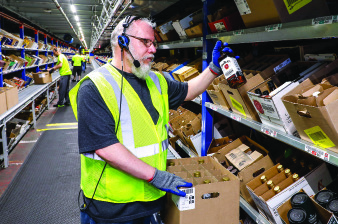 Southern Glazer’s Wine and Spirits LLC was formed in January 2016, when Southern Wine & Spirits merged with Glazer’s Wine & Spirits. Nationwide, the new company represents more than 2,400 suppliers of wine, spirits, beer and beverages, including more than 5,000 individual brands. The company makes weekly deliveries to approximately 200,000 customers in 44 states, and distributes more than 150 million cases a year to a customer base that ranges from big box retailers and national grocery chains to hotels, retail outlets, neighborhood restaurants, bars and clubs. The Long Island distribution center represents nearly 10 million of those cases and makes regular deliveries to 11,000 customers.
Southern Glazer’s Wine and Spirits LLC was formed in January 2016, when Southern Wine & Spirits merged with Glazer’s Wine & Spirits. Nationwide, the new company represents more than 2,400 suppliers of wine, spirits, beer and beverages, including more than 5,000 individual brands. The company makes weekly deliveries to approximately 200,000 customers in 44 states, and distributes more than 150 million cases a year to a customer base that ranges from big box retailers and national grocery chains to hotels, retail outlets, neighborhood restaurants, bars and clubs. The Long Island distribution center represents nearly 10 million of those cases and makes regular deliveries to 11,000 customers.
Over the last 10 years, the wine and spirits industry has been in the midst of a transformation. Twenty years ago, there were close to 1,000 wholesalers/distributors. Today, that number is close to 400 and the top five dominate 50% of their markets. New York is no exception to that rule, according to Kohn. “If you go back 25 years, there were 30 distributors in New York,” he says. “Today, there are really only two national distributors in the New York metropolitan area plus a few hundred that vary in size and ship in from New Jersey.”
The customer has also changed. Instead of one delivery a week, many—if not most—customers expect daily deliveries, with some 2,000 of those customers in Manhattan demanding a morning delivery. What’s more, half of Southern Glazer’s customers wait until the last two hours of the day to place their orders for next-day delivery.
“We’re in a world where customers no longer have room for storage in their facilities, so they rely on our warehouse as their storage location,” Kohn says. “What’s more, the market is so competitive that if we can’t get everything received, picked and delivered the next day, we’ve not met our service goals.”
Those two dynamics—a consolidating industry coupled with demanding customers—drove the needs for change at the Syosset distribution center. When Southern Glazer’s purchased the facility in 2004, it comprised about 325,000 square feet, which was expanded by 150,000 square feet of storage space in 2010. As business continued to grow, Southern Glazer’s rented a neighboring location. In addition, the network includes a bulk storage warehouse in Linden, N.J., that stores about one million cases.
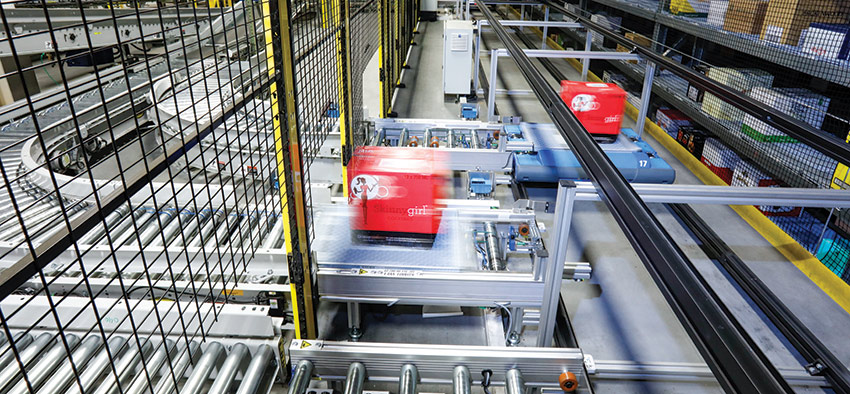
Even with the storage expansion, Kohn, Booth and their team realized the facility faced challenges meeting increased demand and the increasing number of products introduced on a regular basis by the wine and spirits industry. Like the heroes in Jaws, who needed a bigger boat, the Southern Glazer’s team knew it needed a bigger engine.
“We had expanded the building with the ability to store more product,” says Booth. “We had the capability to get it in the building. Now, we had to get it out the door.”
Phase 1: A better conveyor
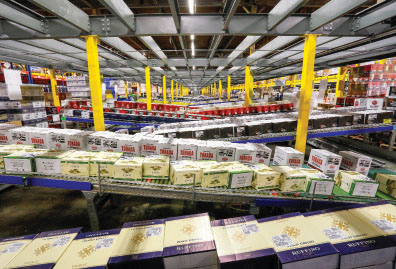 Phase 1 was launched in 2015 with an overhaul of the conveyor and sortation system.
Phase 1 was launched in 2015 with an overhaul of the conveyor and sortation system.
The initiative involved a number of improvements. One was the installation of an additional case pick line to handle the increase in order volume, bringing the total to 13 pick lines. Similarly, the truck-loading area was expanded from 10 to 12 dock doors. The number of conveyor lines delivering cases to an accumulation area grew to 17—nine lines from one area and eight lines from another. From the accumulation area, two lines are combined to singulate cases into one line that travels to the sorter.
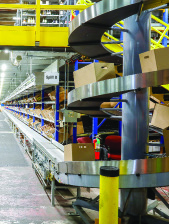 Further improvements came by replacing incline conveyors from the sorter to the dock doors with spiral conveyors. The existing sorter was kept in place, since it could meet the volume requirements, but the warehouse control system was upgraded.
Further improvements came by replacing incline conveyors from the sorter to the dock doors with spiral conveyors. The existing sorter was kept in place, since it could meet the volume requirements, but the warehouse control system was upgraded.
At the end of that phase, Southern Glazer’s now had an infrastructure in place that could move goods through the facility at a rate to meet customer demands with room for growth.
Phase 2: Bottle pick
Near the end of 2015, Southern Glazer’s launched Phase 2, which was the installation of a new, two-level bottle pick room, an area used to build mixed cases. With the constant introduction of new products in the wine and spirits industry, more and more customers order less-than-case load quantities.
As the number of SKUs expanded, so did the amount of walking required to fill the orders. “We had an older, less productive bottle pick area,” says Kohn. “We needed to upgrade the physical bottle room as well as the picking process, and we wanted it in a better location in the building.”
Using a two-level design and best practices from other facilities, the first step was to relocate the bottle pick area to a better spot in the DC. In the new design, the fastest-moving SKUs are located on the ground level; slow-moving items are stored on the upper level. Orders start on the ground level and then are conveyed to the mezzanine level if required.
“By expanding to a two-level configuration, we grew our pick locations by 20% to 25%,” says Booth. “At the same time, we were able to reduce the amount of travel time and increase picking productivity because we’re doing a more effective job of slotting. Product is in the right locations for efficient picking.”
Phase 3: Technology upgrades
With a new conveyor system and a split case pick module in place, Southern Glazer’s launched Phase 3 in July 2016. It involved technology upgrades, including a new WMS and an upgrade of the voice recognition system. But it also involved new processes to manage the fastest-moving and slowest-moving items in the facility, including those that are stored in limited quantities. “We believed that if we could key in on the slowest- and fastest-moving items, we would make a real impact on productivity,” says Kohn.
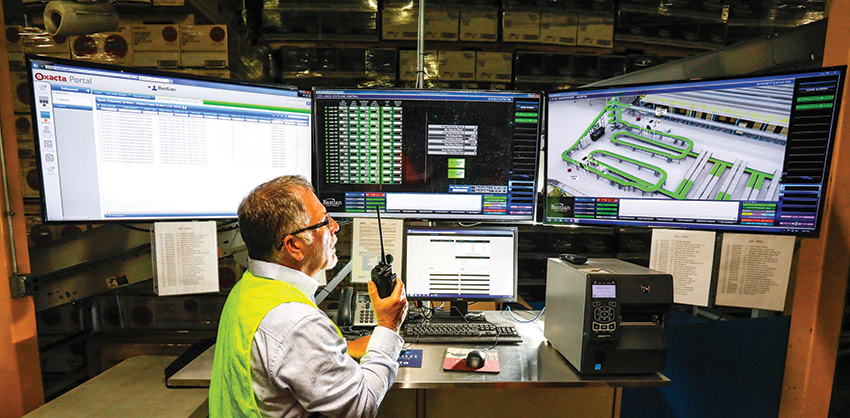
The case dispenser, which handles the fastest-moving items in the facility and accounts for about 20% of nightly volume, is a first in the Southern Glazer’s network. “The idea was to concentrate and automate the handling of our fastest-moving items,” Kohn says. “Rather than have 12 or so case pick lines with two or three dedicated fast-movers on each, we separate out the medium- and fast-movers and developed a more balanced and more productive picking operation.”
The case dispenser consists of two conveyor lines with an automatic labeling system. Each line is fed by 24 accumulation lanes. Each lane is dedicated to a single SKU and can hold 80 cases. When order fulfillment begins, the system automatically withdraws cases from individual lanes as needed. The cartons then go through the automatic labeling system and are conveyed to the sortation system. Replenishment pallets are staged at the end of each of the lanes and lights alert an associate as to when a lane needs to be replenished. “By automating the labeling process, we take away a piece of the human element because associates don’t have to apply a label to each case,” Booth says.
The slowest-moving SKUs, oddballs—product that is stored in very low quantities, and returns were addressed with a shuttle system capable of storing 25,000 cases. The shuttle system not only provides dense, space-saving storage for slow-moving items, it also automates two labor-intensive processes.
At receiving, the WMS identifies items with low demand and returned items, and it directs them to the shuttle, where they are automatically inducted into storage. That eliminates travel time and reduces the number of times those items are handled. When fulfillment begins in the evening, cases in demand are automatically pulled from storage, labeled and conveyed to the sorter. “We’re able to touch a case once to induct it into the shuttle, and then not touch it again until we load it onto a truck,” says Kohn.
The shuttle has also brought a new level of productivity to the picking of slow-moving items. “In the old days, we’d have a limited number of hours to pick the odd balls, which involved a lot of travel through the warehouse,” says Booth. “Now, the system identifies the items that should be stored in the shuttle. They’re all there when we are ready to start the equipment at night and are automatically dispensed onto the conveyor and sent to the sorter.”
With the first three phases under their belts, Kohn and Booth say one more project lies ahead, which is looking at the overall network. The first step was the addition of a crossdock facility just 15 minutes outside of Manhattan in Long Island City. The facility receives full truck loads throughout the night and then sends out route trucks into Manhattan. The next step is to transform the bulk storage facility in New Jersey into a full-line distribution center, with a state-of-the-art sortation system and high-density rack storage. “The facility is scheduled to go live in September as we continue to look for a permanent New York solution. That will allow us to peel off a percentage of our volume in Syosset and handle even higher volumes than we do today,” Kohn says. “All told, we have facilities that are up to the task of handling the demands in New York.”
Take a look inside the new Syosset, New York distribution center.

Article Topics
Latest in Logistics
LM Podcast Series: Assessing the freight transportation and logistics markets with Tom Nightingale, AFS Logistics Investor expectations continue to influence supply chain decision-making The Next Big Steps in Supply Chain Digitalization Under-21 driver pilot program a bust with fleets as FMCSA seeks changes Diesel back over $4 a gallon; Mideast tensions, other worries cited Four U.S. railroads file challenges against FRA’s two-person crew mandate, says report XPO opens up three new services acquired through auction of Yellow’s properties and assets More LogisticsAbout the Author
Subscribe to Logistics Management Magazine

Find out what the world's most innovative companies are doing to improve productivity in their plants and distribution centers.
Start your FREE subscription today.
April 2023 Logistics Management

Latest Resources














